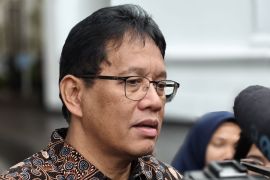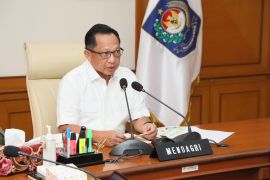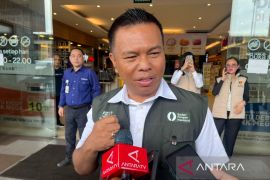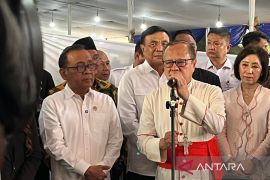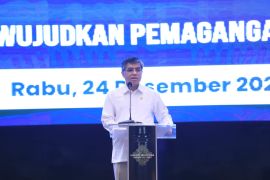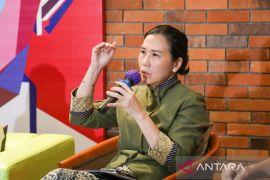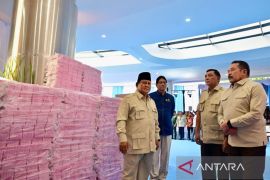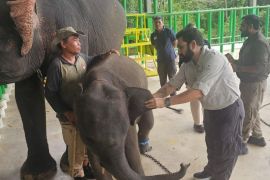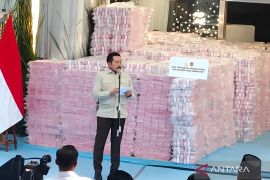He and President Susilo Bambang Yudhoyono formalized a new Comprehensive Partnership agreement between the US and Indonesia in Jakarta, on November 9, 2010.
In a joint declaration between the Indonesian and US governments, the Comprehensive Partnership was described as a dynamic 21st century partnership with a forward-looking agenda to advance bilateral cooperation in many areas : education, environment, security, science and technology, trade and investment, democracy, human rights, health, energy, food, entrepreneurship, and more.
Previously, on March 30, 2010, the then US Ambassador to Indonesia Cameron R. Hume and Research and Technology Minister Suharna Surapranata had signed a bilateral agreement on scientific and technological cooperation between the US and Indonesia.
The bilateral framework agreement is aimed at strengthening and promoting scientific research and technological cooperation based on shared responsibilities, equitable contributions and benefits.
Cooperation activities under this agreement could include exchange of scientific and technological experts, information, and best practices; joint research projects; joint seminars, meetings and workshops; and the development of direct cooperation between government agencies, universities, and other entities of the two countries.
The previous Agreement for Cooperation in Scientific Research and Technological Development between the United States and Indonesia was signed in 1992 but expired in 2002.
Obama`s serious intention to establish scientific cooperation with Indonesia has been proven by sending US Science Envoy Dr. Bruce Alberts to Indonesia twice, first in May 2010 and second in December 2010.
During his second visit in Indonesia in December 2010, Obama`s Science Envoy Dr. Bruce Alberts met with distinguished members of Indonesia`s science community, including former President BJ Habibie, to discuss concrete ways the U.S. and Indonesia can work together to promote scientific collaboration.
Dr. Bruce Alberts is a prominent biochemist who currently serves as editor-in-chief of Science magazine. He is also a professor emeritus in the Department of Biochemistry and Biophysics at the University of California, San Francisco.
The U.S. Science Envoy Program is a core element of the new strategy of global engagement outlined in the President Obama`s June 4, 2009 "New Beginning" speech in Cairo when he spoke of building partnerships to support science and technological development in Muslim-majority countries.
Following President Obama`s Cairo speech, US Secretary of State Hillary Clinton named the first three science envoys - Elias Zerhouni, Ahmed Zewail, and Bruce Alberts -- in Marrakech, November 2009.
In the wake of President Obama`s Cairo speech, a joint oceanic expedition dubbed INDEX-SATAL 2010 was conducted by the US and Indonesia, from June to August 2010.
The joint expedition was staged from two ships: the National Oceanic Atmospheric Administration (NOAA)`s Okeanos Explorer and the Indonesian Agency for Assessment and Application of Technology (BPPT)`s research vessel Baruna Jaya IV, and at Exploration Command Centers (ECCs) ashore.
At least 32 scientists and technicians both on the ships and on shore carried out exploratory investigations on the diversity and distribution of deep sea habitats and marine life in unknown ocean areas in SATAL - a contraction of Sangihe and Talaud - two island chains stretching northeast of North Sulawesi, Indonesia.
"Indonesian waters are home to more marine biodiversity than anyplace else in the world. We explore together to better understand, use, and protect the ocean and its resources," Dr Jane Lubchenco, Ph.D., US under secretary of commerce for oceans and atmosphere and NOAA Administrator, said when launching the joint expedition last July.
Sugiarta Wirasantosa Ph.D, Indonesia`s chief scientist for the joint expedition and principal investigator at Indonesia`s Agency for Marine and Fishery Research, said last July that "Ocean-related concerns, including food security and protecting ocean ecosystems that support fisheries, affect many nations including Indonesia`s nation of 17,000 islands."
The joint expedition has made many interesting discoveries such as previously unknown submarine volcanoes, a large hydrothermal field with a thriving exotic animal ecosystem, and areas rich in deep-sea ocean animals.
In the first week of the joint expedition, Okeanos Explorer`s built-in multibeam sonar had mapped a huge undersea volcano.
Cameras on the ship`s remotely-operated vehicle, meanwhile, took high-definition images of the feature called Kawio Barat, referring to the ocean area west of Kawio Islands, the US embassy in Jakarta said on its official website last July.
"This is a huge undersea volcano, taller than all but three or four mountains in Indonesia, and rising more than ten thousand feet from the seafloor in water more than eighteen thousand feet deep," said Jim Holden, US chief scientist for the first leg of the joint expedition and a microbiologist from the University of Massachusetts in Amherst, who operated from an Exploration Command Center in Jakarta, last July.
At an American Geophysical Union press conference in San Francisco, US, in December 2010, scientists explained that while the exploration area is recognized as one of the Earth`s major shallow water centers of marine diversity, little was known about the marine life inhabiting its deep areas until this mission.
"This expedition was exciting and productive in many respects," said Sugiarta Wirasantosa, Ph.D, as quoted on the official website of NOAA.
"Within the 'Coral Triangle,' a 2.3 million-square-mile area (6 million square km) in which the Sulawesi is included, more than 65 percent of the world`s reef-forming coral species are known to exist in shallow waters," said Santiago Herrera, a graduate student at the Massachusetts Institute of Technology and the Woods Hole Oceanographic Institution who participated in the expedition.
As many as 50 animal species caught on high-definition video appeared to be new to science, in addition to possibly 40 new coral species such as the Bubblegum coral, known formally as Paragorgia arborea.
According NOAA, this expedition was the first in a multiyear plan for Indonesia and the United States to explore marine environments together as part of a larger partnership that foresees NOAA, Indonesia`s Ministry of Marine Affairs and Fisheries, and BPPT partnering on issues of mutual interest including ocean exploration, fisheries and food security, climate change and tsunami research.
The U.S. Embassy Jakarta hosted an interactive webchat entitled, "Live from the Seafloor: A Dynamic Look at the U.S.-Indonesia Science and Technology Partnership", on January 7, 2011.
The webchat that highlighted the historic US-Indonesia joint ocean expedition, featured a live panel discussion with five U.S. and Indonesian dignitaries, namely NOAA Administrator Dr. Jane Lubchenco; U.S. Science Envoy Dr. Bruce Alberts and Indonesian Ambassador to the United States Dr. Dino Patti Djalal (in Washington DC), while in Jakarta were U.S. Ambassador to Indonesia Scot Marciel, Indonesian Minister of Marine Affairs and Fisheries Fadel Muhammed and BPPT Chairman Dr. Ir. Marzan A. Iskandar.
According to Marzan, some 79 new species were found in East Indonesian waters during the deep seas explorations.
Minister Fadel Muhammad on the occasion said the joint oceanic expedition had yielded results of benefit to both countries.
He said Indonesia had gained much benefit from the expedition because now it did not have to start from "zero" when exploring its waters.
Fadel said he now even wanted to establish further cooperation in the research field with the US as his ministry had allocated an adequate budget for research activities.
Indonesian Ambassador to US Dino Patti Djalal said the scientific collaboration between Indonesia and the US needed to be intensified as it would bring many benefits to Indonesia and to the world in general.
He said the future of Indonesia was in the hands of those with scientific literacy. (*)
Reporter: Fardah
Editor: Fardah Assegaf
Copyright © ANTARA 2011
